


NICOLAS POUSSIN 1594 - 1665 (L1, J1, C1, CW, C2)
Acknowledgements
Poussin: Self-Portrait – The Louvre, Paris; Bacchanalian Revel – National Gallery, London; Holy Family on Steps (detail) – National Gallery of Art, Washington; Extreme Unction – Fitzwilliam Museum, Cambridge; Le Déluge – The Louvre, Paris. Lorrain: Seaport at Sunset – The Louvre, Paris; Landscape with Hagar and the Angel – National Gallery, London; Embarkation of St. Ursula – National Gallery, London; Enchanted Castle – National Gallery, London; Landscape with cowherd (Evening) – Fine Arts Museum, San Francisco, USA. La Tour: Magdalen with the Smoking Flame – Los Angeles County Museum, USA; St. Sebastian tended by St. Irene – Broglie, Normandy, France; The New-Born Child – Museum of Fine Arts, Rennes, France; Candlelight – The Louvre, Paris; The Dice Players – Preston Hall and Preston Park Museum, Stockton-on-Tees, England.
Including:
Claude Lorrain
and Georges
de La Tour

xxxxxThe French artist Nicolas Poussin, though appointed court painter to Louis XIII in 1640, spent much of his life in Rome. Not surprisingly his works - mostly on biblical and mythological themes - have a strict classical form and show a love of antiquity. In subject and colour he owed much to Raphael and Titian, and he also made a special study of Graeco-Roman sculpture. His early output included the Death of Germanicus, three Bacchanalian scenes for Cardinal Richelieu, The Rape of the Sabine Women, and The Adoration of the Golden Calf. His later, more refined style is to be seen in his Holy Family on the Steps, The Seven Sacraments, The Arcadian Shepherds, The Birth of Bacchus, and his landscape The Four Seasons. In these, his palette is toned down, and his cool tones and clear light create a more dignified style. His classical work influenced Charles Le Brun and, later, inspired both Ingres and David.
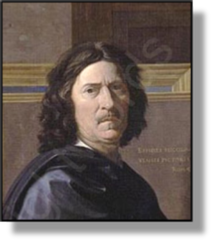 xxxxxAlthough one time court painter to Louis XIII, (1640-2), the French artist Nicolas Poussin spent most of his working life in Rome. It is perhaps not surprising, therefore, that his works are noted for their strict classical form, and are concerned, to a large extent, with biblical and mythological subjects. An exponent of what is termed "Baroque Classicism", he was fascinated with antiquity, and many of his figures were deliberately designed to resemble the varied poses of a decorative frieze. In subject matter and colour he owed much to Raphael and Titian, whilst his landscapes, often lavish and dramatic, played a vital part in creating the appropriate atmosphere for his set piece. He is also remembered for his depiction of The Four Seasons, notably his chilling version of winter, subtitled The Déluge (illustrated below).
xxxxxAlthough one time court painter to Louis XIII, (1640-2), the French artist Nicolas Poussin spent most of his working life in Rome. It is perhaps not surprising, therefore, that his works are noted for their strict classical form, and are concerned, to a large extent, with biblical and mythological subjects. An exponent of what is termed "Baroque Classicism", he was fascinated with antiquity, and many of his figures were deliberately designed to resemble the varied poses of a decorative frieze. In subject matter and colour he owed much to Raphael and Titian, whilst his landscapes, often lavish and dramatic, played a vital part in creating the appropriate atmosphere for his set piece. He is also remembered for his depiction of The Four Seasons, notably his chilling version of winter, subtitled The Déluge (illustrated below).
xxxxxHe was born near Les Andelys in Normandy and decided to become a painter when the artist Quentin Varin visited his village in 1611. He studied for a short while in Rouen and then took himself off to Paris. It was here that he studied the sculpture and paintings of the great masters of the Italian Renaissance and developed a passionate interest in classical antiquity. He decided that his destiny lay in Italy. After working for a short time on the decorations being carried out in the Luxembourg Palace, he managed to raise the fare. In 1624 he was able to leave France and settle in Rome. Apart from a brief visit to Paris in the 1640s, he spent the rest of his life in the Eternal City, continually inspired by its ancient past.
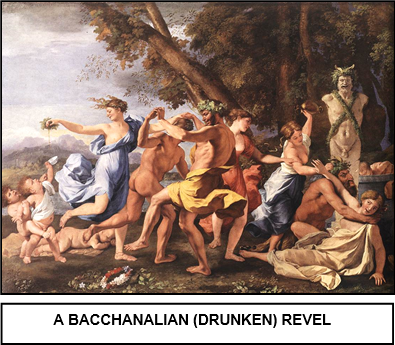
xxxxxAt first he struggled to make ends meet, let alone make a name for himself. He worked for a while with the baroque painter Domenichino, but he also spent much time in studying Graeco-Roman sculpture, and it was this particular knowledge that greatly influenced his artistic style and eventually brought him to the notice of wealthy patrons - in particular the art collector Cassiano dal Pozzo. In 1628 he gained recognition with his The Death of Germanicus, the successful Roman general, and this won him a commission for an altarpiece in Saint Peter's Basilica. When completed in 1630, however, his gruesome Martyrdom of Saint Erasmus was not well received, and from then on he decided to paint only for private patrons. In the 1630s his output included three Bacchanalian scenes, specifically ordered by Cardinal Richelieu, and two action-filled works, The Rape of the Sabine Women and The Adoration of the Golden Calf. At first he emulated the rich, warm colours of the Venetian artist Titian in depicting his mythological, biblical and Bacchanalian scenes, but in later years he toned down his palette, and his style gradually moved from the flamboyant to the dignified.
xxxxxPoussin's short stay in Paris, starting in 1640, was not a happy one. He was invited to return to France by Cardinal Richelieu who, being truly delighted with his scenes of drunken revelry, now wanted him to supervise the decorating of the Long Gallery in the Louvre. He received a very warm welcome and was accorded the title "First Painter", but the honeymoon was short lived. He disliked the cold climate and he could not cope with the rivalry and critical atmosphere within the capital's artistic community - and bluntly said so! Nor was he used to undertaking so large a project. In 1642 he returned to Italy, regarding his stay in Paris, as a journey "from paradise into hell".
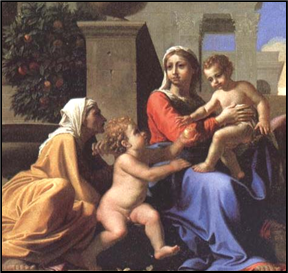
xxxxxOn his return to Rome, his work showed a more restrained style - particularly in his biblical scenes - and he gave more time to landscape painting - as in his The Four Seasons. To this period belongs his Holy Family on the Steps of 1648 (detail illustrated), an outstanding painting which was based on clear, geometric forms and, by its cool tones and clear light, created an atmosphere of calm solemnity. Such qualities were also to be seen in the scenes he painted for his two series of The Seven Sacraments. Here, his Confirmation and Extreme Unction (illustrated below) are particularly worthy of note.
xxxxxFor the last ten years or so of his life he suffered ill health. He produced two particularly fine works during this period -The Arcadian Shepherds and the Birth of Bacchus - but in 1664 he gave away his unfinished Apollo and Daphine, knowing full well that he did not have the time to complete it. He died the following year and was buried in San Lorenzo in Lucina, his parish church in Rome.
C1-1625-1649-C1-1625-1649-C1-1625-1649-C1-1652-1649-C1-1625-1649-C1-1625-1649-C1
xxxxxHis influence in Italy was not extensive, the taste here being for the bold art of Roman baroque, but in France his style had a profound and lasting effect. In fact, the French Academy, under the directorship of Charles Le Brun - who had one time worked in Rome under Poussin's supervision - officially adopted his neoclassical style, admiring its order and clarity. To the members of this august and powerful institution, he possessed the same qualities of rational discipline that they so much admired in the classical theatre of Corneille and Racine. It is hardly surprising, then, that the works of Poussin should provide the dominant inspiration for eighteenth century French artists such as David and Ingres.
xxxxxPoussin’s interest in landscape was shared by his compatriot Claude Lorrain (1600-82), and at one time they worked together on drawings and sketches. He also spent most of his working life in Rome and, as his paintings show, he was also fascinated by ancient ruins. Regarded by some as the founder of European landscape painting, his break through came in the 1630s, when he produced two works for the pope, La Fête Villageoise and Un Port de mer au soleil couchant. These brought him fame and many commissions. Notable for their dream-like quality, their illusion of depth, and their serene, idealized landscapes, his works included Landscape with Hagar and the Angel, the Enchanted Castle, and his series of imagined seaports, such as Seaport with the Landing of Cleopatra in Tarsus and the Embarkation of St. Ursula.
xxxxxPoussin's interest in landscape as a subject in its own right was more than echoed by his compatriot Claude Lorrain (1600-82). Indeed, at one time the two artists worked together in making drawings and sketches for this very purpose. Both, it must be said, were directly inspired by the landscapes of their contemporary Domenichino, a pioneer in this genre, but it was Claude Lorrain who developed the genre further and came to be regarded by some as the founder of European landscape painting. Like Poussin, he spent most of his working life in Rome, but, unlike him, his work was "classical" in subject matter only, not in style.
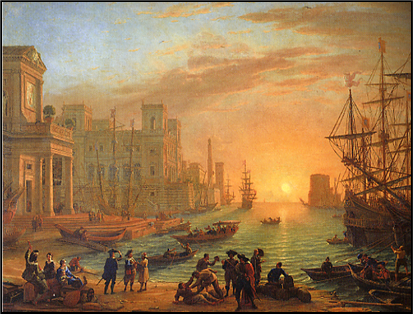
xxxxxHe was born in the village of Chamagne in the duchy of Lorraine - hence his assumed name - and was orphaned at the age of 12. After putting his hand to a number of trades - including woodcarving and pie making - he eventually worked his way to Italy. Here, his principal teacher was the Italian painter Agostino Tassi, but, apart from Domenichno, he was also influenced by the German painter Adam Eisheimer, particularly in his treatment of light. He first worked as a fresco painter, but, fascinated by the ancient ruins in and around Rome, he soon took to easel pictures, concentrating on landscape painting. His break-through came in the mid- 1630s when he was introduced to Pope Urban VIII and commissioned to produce two paintings, La Fête Villageoise and Un Port de mer au soleil couchant (similar to the illustration). These works brought him fame and a deluge of orders from patrons and art connoisseurs alike. By 1637 he was working on commissions from Philip IV of Spain, and had become the most famous landscape painter in Italy.
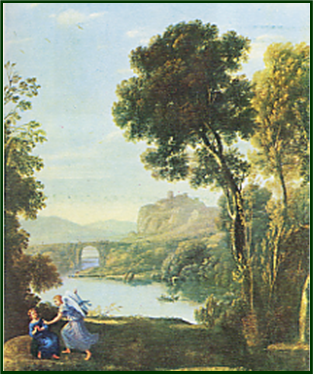 xxxxxHis paintings, conveniently linked with some mythological or historical event, are generally dream-like in quality and follow a set pattern of composition designed to create the illusion of depth (a method known in France as repoussoir - "to push back"). And these idealized, imagined landscapes, both stately and serene, were romantically enhanced by the glimpse of a distant medieval castle or classical ruin. Figures had to be included - often in pastoral or antique dress - but they were totally subordinate to nature's backdrop. Among works of this nature were his Landscape with Narcissus and Echo (1644), Landscape with Hagar and the Angel (1646) (illustrated), The Marriage of Isaac and Rebekah (1648), and The Enchanted Castle (1664) (illustrated below) - all in the National Gallery, London. Famous, too, are his series of idealized seaports such as his brilliant Seaport with the Landing of Cleopatra in Tarsus (1642), Seaport with the Embarkation of the Queen of Sheeba (1648) and the Embarkation of St. Ursula - illustrated below alongside its recorded drawing. Only in a few cases, such as his View of the Tiber, is the make-believe world abandoned for a landscape taken directly from nature.
xxxxxHis paintings, conveniently linked with some mythological or historical event, are generally dream-like in quality and follow a set pattern of composition designed to create the illusion of depth (a method known in France as repoussoir - "to push back"). And these idealized, imagined landscapes, both stately and serene, were romantically enhanced by the glimpse of a distant medieval castle or classical ruin. Figures had to be included - often in pastoral or antique dress - but they were totally subordinate to nature's backdrop. Among works of this nature were his Landscape with Narcissus and Echo (1644), Landscape with Hagar and the Angel (1646) (illustrated), The Marriage of Isaac and Rebekah (1648), and The Enchanted Castle (1664) (illustrated below) - all in the National Gallery, London. Famous, too, are his series of idealized seaports such as his brilliant Seaport with the Landing of Cleopatra in Tarsus (1642), Seaport with the Embarkation of the Queen of Sheeba (1648) and the Embarkation of St. Ursula - illustrated below alongside its recorded drawing. Only in a few cases, such as his View of the Tiber, is the make-believe world abandoned for a landscape taken directly from nature.
xxxxxBut important though his contribution was to the general development of landscape painting, Claude Lorrain is remarkable above all for his masterly treatment of light. No previous artist had captured with such perfection the beauty and variety of natural light, or suffused their scenes with such a warm, golden glow. A distinctive feature of his early works was the brilliant way in which he rendered the morning or evening sunlight, as seen in his Seaport with Setting Sun of 1639 (illustrated above). Indeed, in his earlier work, his Harbour Scene of 1634, he was probably the first Western artist to use the sun as a direct source of illumination. Later, as in his The Embarkation of Saint Ursula (illustrated below), he came to bathe the whole scene in a soft, limpid light.
xxxxxIn 1635, fearing that his paintings might be open to forgery, he began his Liber Veritatis (Book of Truth), a unique pictorial record of his compositions. This proved of immense value in assessing the artist's stylistic development, dating his works and identifying his patrons. The book, made up of 195 carefully drawn copies of his paintings, is housed in the British Museum, London. When, at a later date, engravings were made of these drawings, they had a profound influence on landscape artists of the 19th century. Illustrated here is the Embarkation of Saint Ursula together with its record.
xxxxxClaude Lorrain died in Rome in November 1682, and was buried in the Church of the Saints Trinita dei Monti. About 250 of his paintings survived out of a total of 300, and he left more than a thousand drawings and 44 etchings. His art influenced many European landscape painters, notably the Dutch painter Aelbert Cuyp, the Welsh artist Richard Wilson, the English painter Joseph Mallord William Turner, and the French impressionists.
xxxxxIncidentally, The Enchanted Castle was the work which inspired the English poet John Keats by conjuring up (as it does) the existence of a mystical, legendary land.
xxxxxThe religious and domestic scenes of the French artist Georges de La Tour (1593-1652) were noted for their stark contrast of light and shade and their single source of light. His work is reminiscent of Caravaggio, but his geometric composition gives his work a feeling of serenity and something of a modern look. This is best seen in works like The New-born Child and St. Peter Denying Christ. Among his patrons was Cardinal Richelieu, but his fame did not outlive his lifetime, and it was not until the 20th century that his work was “rediscovered”, and he became recognised as one of the major artists of Western Europe.
xxxxxAnother French artist of this time was Georges de La Tour (1593-1652). Like Claude Lorrain, he was born in Lorraine, but apart from a period of training - possibly in Italy or the Netherlands - he spent almost his entire life in the duchy, probably at Lunéville. Here, his religious and domestic scenes were noted for their stark contrast of light and shade, and for their single source of light - often a candle or a torch as in the case of Magdalen with the Smoking Flame, completed in 1640, and his later work, Saint Sebastian being tended by Saint Irene (both illustrated below on left).
xxxxxHis work is reminiscent of Caravaggio - possibly via the influence of the Dutch so-called "candle-light" painters - but he also developed an attractive style based on a geometric composition which bordered on the abstract. This not only produced stylized figures and an inexplicable feeling of serenity, but it gave to his paintings a clean-cut modern appearance, best seen in works such as The Penitent Magdalene, Nativity, St. Peter Denying Christ and The New-born Child (illustrated above on right). Unlike Caravaggio, however, he did not go in for dramatic effect. His religious paintings were meditative in mood, and instilled with a strong sense of piety and humility, captured by the simplicity of form and the beauty of the light.
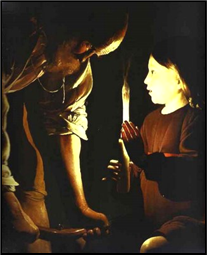
xxxxxBut not all his works were centred on religious themes. His genre scenes, mostly painted early on in his career, included The Brawl, The Hurdy-Gurdy Player - a realistic observation of a blind and destitute street musician (once 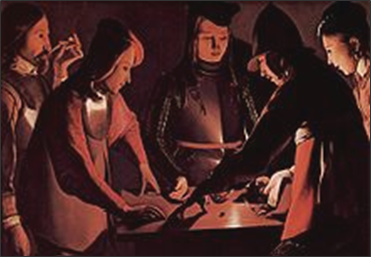 attributed to Velasquez), The Fortune Teller (one time thought to be a forgery), and Candlelight and The Dice Players (both illustrated here).
attributed to Velasquez), The Fortune Teller (one time thought to be a forgery), and Candlelight and The Dice Players (both illustrated here).
xxxxxHe was patronized, amongst others, by the Duke of Lorraine and Cardinal Richelieu, and we are told that the French king, Louis XIII, having received one of his paintings as a gift, was so delighted with it that he had all other paintings removed from his apartments! But despite the value placed on his work during his lifetime, his fame was transitory. For many years his work received little notice, and it was not, in fact, until the beginning of the 20th century that his paintings were "rediscovered" and reassessed. Today, La Tour ranks among the major artists of Western Europe.

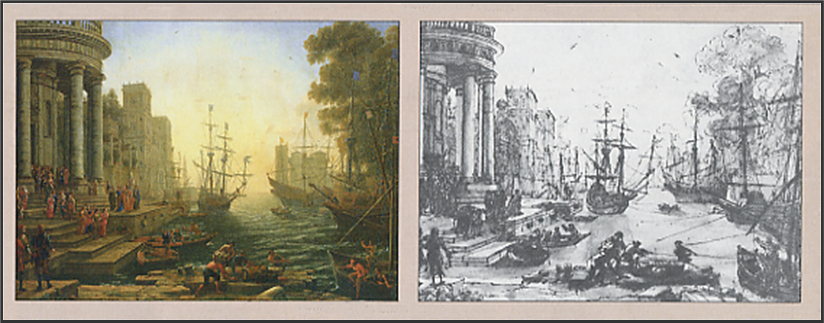









 xxxxxAlthough one time court painter to Louis XIII, (1640-
xxxxxAlthough one time court painter to Louis XIII, (1640-


 xxxxxHis paintings, conveniently linked with some mythological or historical event, are generally dream-
xxxxxHis paintings, conveniently linked with some mythological or historical event, are generally dream-
 attributed to Velasquez), The Fortune Teller (one time thought to be a forgery), and Candlelight and The Dice Players (both illustrated here).
attributed to Velasquez), The Fortune Teller (one time thought to be a forgery), and Candlelight and The Dice Players (both illustrated here).





